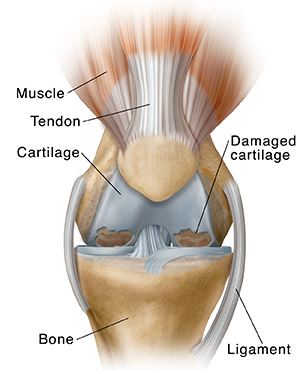What Is Osteoarthritis?
Arthritis is inflammation or swelling of 1 or more joints. A joint is a point in the body where 2 or more bones come together. There are about 100 different types of arthritis. Arthritis may cause problems in the tissue near the joints. This includes muscles, tendons, and ligaments. And in some types of arthritis, the entire body can be affected.
Osteoarthritis (OA) is also known as wear-and-tear arthritis. It's the most common type of arthritis. With OA, the cartilage wears away. Cartilage is a slick tissue that covers the ends of the bones. It acts as a cushion. It allows them to glide smoothly against each other. When the cartilage wears away, bone rubs against bone. This causes pain, swelling, and stiffness.
 |
| Normal knee |
 |
| Knee with osteoarthritis |
What happens in osteoarthritis?
Researchers do not know what triggers or starts the breakdown of the tissues in the joint. But as osteoarthritis begins to develop, it can damage all the areas of the joint, including:
-
Cartilage, the tissue that covers the ends where 2 bones meet to form a joint
-
Tendons and ligaments
-
The lining of the joint (synovium)
-
Bone
-
Meniscus (type of cartilage between bones) in the knee
Risk factors
Risk factors for OA include:
Symptoms
OA can affect any joint. Weight-bearing joints are often affected. This includes the hips and knees. Common symptoms are joint pain and stiffness. These may get worse with inactivity or overuse. You may have more stiffness first thing in the morning, usually for less than 30 minutes. Or you may have stiffness after sitting for a long time. You may have more pain in your hips or knees if you walk more than normal.
Other common symptoms include:
-
Weak muscles
-
Unstable or wobbly joints
-
Grinding or crackling noises with motion
-
Joints with swelling or bumps
-
Unable to bend and straighten joints (reduced range of motion)
If you have any of these joint changes, see your healthcare provider. You can work together to create a treatment plan. This plan may help lessen your pain and stiffness. It may prevent your symptoms from getting worse.
Online Medical Reviewer:
Marianne Fraser MSN RN
Online Medical Reviewer:
Rajadurai Samnishanth
Online Medical Reviewer:
Rita Sather RN
Date Last Reviewed:
3/1/2024
© 2000-2025 The StayWell Company, LLC. All rights reserved. This information is not intended as a substitute for professional medical care. Always follow your healthcare professional's instructions.